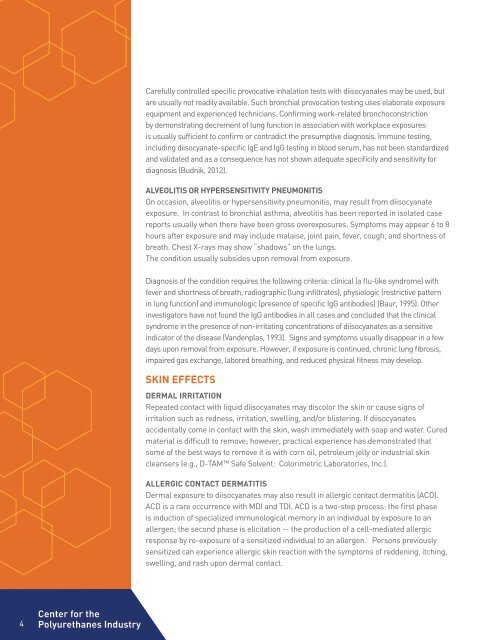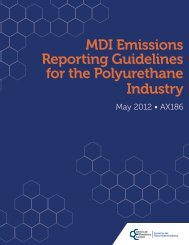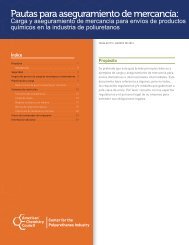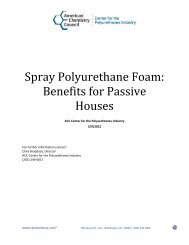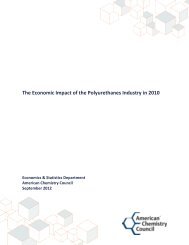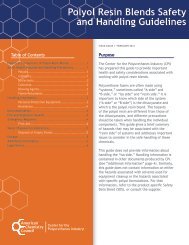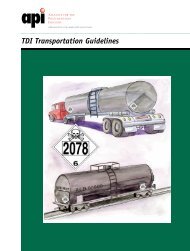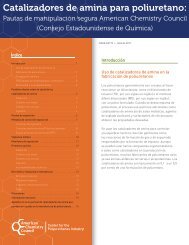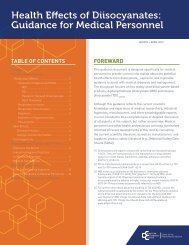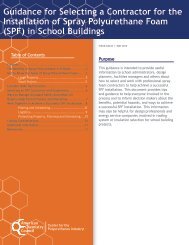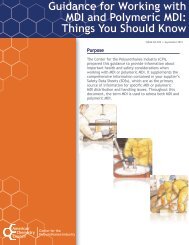Health Effects of Diisocyanates: Guidance for Medical Personnel
Health Effects of Diisocyanates: Guidance for Medical Personnel
Health Effects of Diisocyanates: Guidance for Medical Personnel
You also want an ePaper? Increase the reach of your titles
YUMPU automatically turns print PDFs into web optimized ePapers that Google loves.
4<br />
Center <strong>for</strong> the<br />
Polyurethanes Industry<br />
Carefully controlled specific provocative inhalation tests with diisocyanates may be used, but<br />
are usually not readily available. Such bronchial provocation testing uses elaborate exposure<br />
equipment and experienced technicians. Confirming work-related bronchoconstriction<br />
by demonstrating decrement <strong>of</strong> lung function in association with workplace exposures<br />
is usually sufficient to confirm or contradict the presumptive diagnosis. Immune testing,<br />
including diisocyanate-specific IgE and IgG testing in blood serum, has not been standardized<br />
and validated and as a consequence has not shown adequate specificity and sensitivity <strong>for</strong><br />
diagnosis (Budnik, 2012).<br />
ALVEOLITIS OR HYPERSENSITIVITY PNEUMONITIS<br />
On occasion, alveolitis or hypersensitivity pneumonitis, may result from diisocyanate<br />
exposure. In contrast to bronchial asthma, alveolitis has been reported in isolated case<br />
reports usually when there have been gross overexposures. Symptoms may appear 6 to 8<br />
hours after exposure and may include malaise, joint pain, fever, cough, and shortness <strong>of</strong><br />
breath. Chest X-rays may show “shadows” on the lungs.<br />
The condition usually subsides upon removal from exposure.<br />
Diagnosis <strong>of</strong> the condition requires the following criteria: clinical (a flu-like syndrome) with<br />
fever and shortness <strong>of</strong> breath, radiographic (lung infiltrates), physiologic (restrictive pattern<br />
in lung function) and immunologic (presence <strong>of</strong> specific IgG antibodies) (Baur, 1995). Other<br />
investigators have not found the IgG antibodies in all cases and concluded that the clinical<br />
syndrome in the presence <strong>of</strong> non-irritating concentrations <strong>of</strong> diisocyanates as a sensitive<br />
indicator <strong>of</strong> the disease (Vandenplas, 1993). Signs and symptoms usually disappear in a few<br />
days upon removal from exposure. However, if exposure is continued, chronic lung fibrosis,<br />
impaired gas exchange, labored breathing, and reduced physical fitness may develop.<br />
SKIN EFFECTS<br />
DERMAL IRRITATION<br />
Repeated contact with liquid diisocyanates may discolor the skin or cause signs <strong>of</strong><br />
irritation such as redness, irritation, swelling, and/or blistering. If diisocyanates<br />
accidentally come in contact with the skin, wash immediately with soap and water. Cured<br />
material is difficult to remove; however, practical experience has demonstrated that<br />
some <strong>of</strong> the best ways to remove it is with corn oil, petroleum jelly or industrial skin<br />
cleansers (e.g., D-TAM TM Safe Solvent: Colorimetric Laboratories, Inc.).<br />
ALLERGIC CONTACT DERMATITIS<br />
Dermal exposure to diisocyanates may also result in allergic contact dermatitis (ACD).<br />
ACD is a rare occurrence with MDI and TDI. ACD is a two-step process: the first phase<br />
is induction <strong>of</strong> specialized immunological memory in an individual by exposure to an<br />
allergen; the second phase is elicitation -- the production <strong>of</strong> a cell-mediated allergic<br />
response by re-exposure <strong>of</strong> a sensitized individual to an allergen. Persons previously<br />
sensitized can experience allergic skin reaction with the symptoms <strong>of</strong> reddening, itching,<br />
swelling, and rash upon dermal contact.


